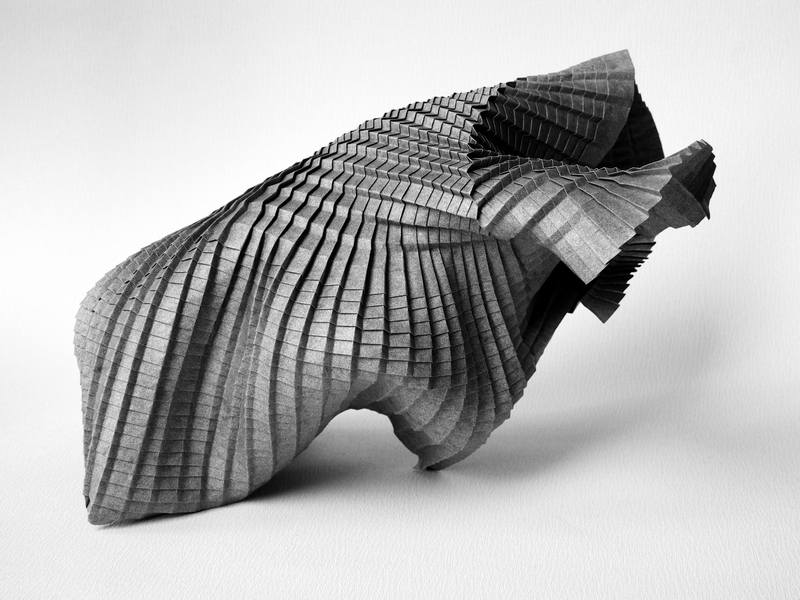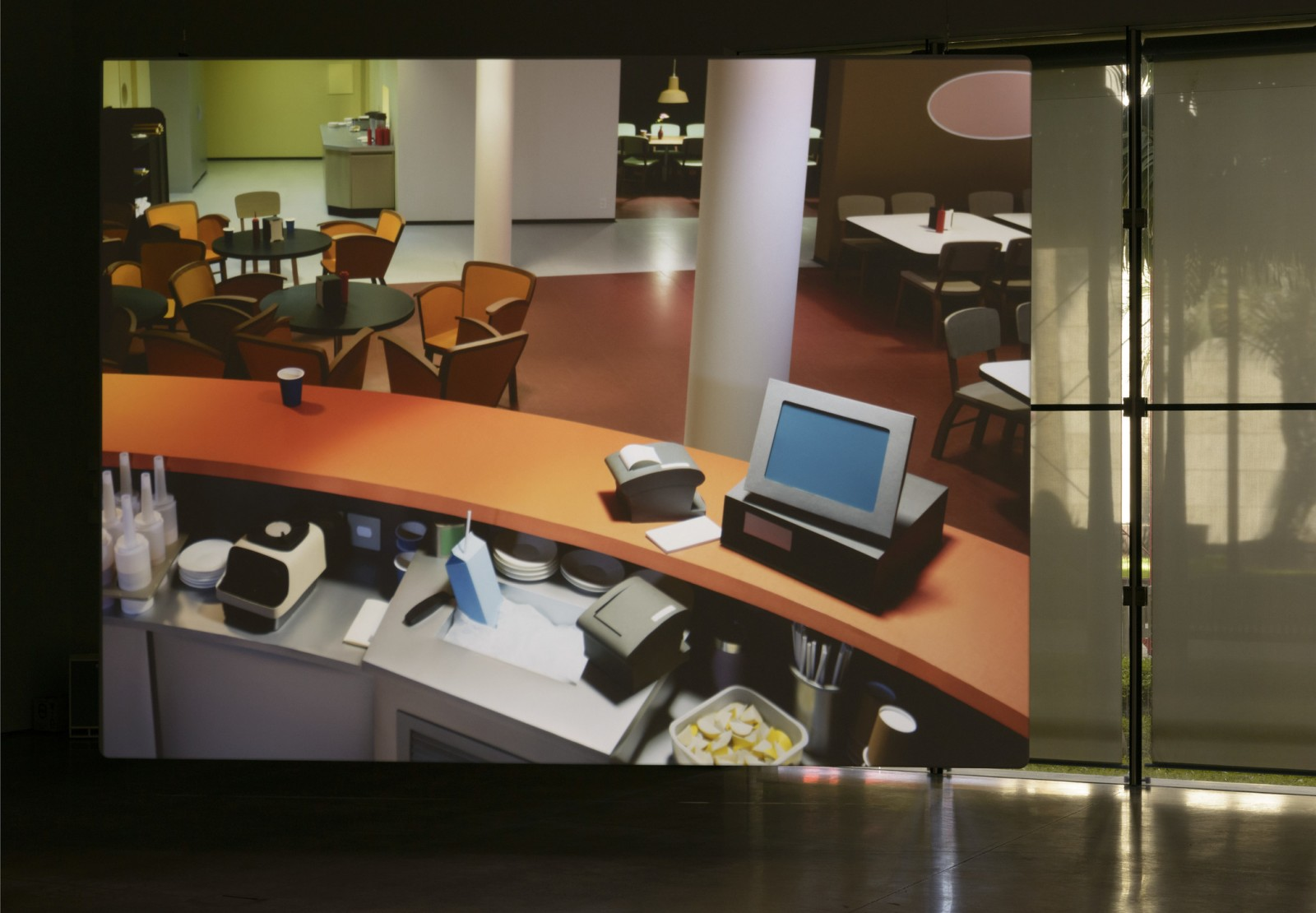Do Ho Suh
Do Ho Suh was exhibiting at the Henry Moore Centre in Leeds not that long ago. I have looked at his work before as a cross between drawing and sculpture, his material meshes working as if they were assembled from full scale technical drawings of architectural environments. However you could also think of his work as a very portable way of carrying information around, and as such to begin thinking about certain sorts of drawing as portable sculpture.

A few years ago Do Ho Suh papered over much of the interior of a four-storey New York townhouse. He used thin paper, stuck down with a soft glue, and delicately worked the paper over fixtures such as radiators or pipes. He was sort of caressing the surface, treating it as a kind of second skin. Finally he coated his fingers in blue pastel and rubbed himself into the walls, and floor and fireplace and shelving, ‘caressing them’ as he put it. He went on to rub different colours into the surfaces of the other rooms. The rubbing got less intense the higher up the house he got and the rooms less familiar. Suh remarked on observing he rubbed away his fingerprints; ‘I gave part of my body’
Do Ho Suh: Papered and pastel coated room
I was in particular fascinated by photographs of Do Ho Suh's rubbings of fixtures and fittings, such as the one below. It operates in a very strange space that sits between photography, drawing and sculpture.
Do Ho Suh: Photograph of a paper covered sink that has been rubbed with a blue pencil crayon
Photograph of a paper covered radiator
The paper covered radiator is more sculptural and if the paper surface was carefully removed from its metal underpinning, it could become a free standing sculpture. Because the sink photograph has no visual edges to it, we become more aware of the direction of marks taken by the rubbing process, and this makes it more like a drawing. In either case the idea of drawing as portable sculpture still seems viable, so perhaps its worth opening the idea out a little further.
Frances Richardson remarked that she thought of some of her drawings as thin sculpture. Blueprints can be thought of as thin plans for sculpture. When we make a map we think of it as a flat drawing. However when you buy an ordnance survey map it comes as a folded object.
Opening out a folded map
The folded paper is very sculptural and of course the art of folding flat paper into complex three dimensional forms can reach extremely high levels of complexity. Arisawa Yuga's design for an origami dragon being typical of the thinking processes that allow us to think about the relationship between a flat drawing and a sculptural form.
Arisawa Yuga: Dragon
So could we think about Arisawa Yuga's design for an origami dragon as another form of portable sculpture? If we look at a very formal set of folds by Paul Jackson, such as the parallel, but unequal v-pleats below, we see a more engineering than sculptural set of concepts in action. In fact the conceptual thinking around paper folding is even more interesting than simply thinking of how two dimensions can become three. A 'No' crease is a one-dimensional point which creates a dent in the paper called a 'Break'. This generates complex curves in the paper, which can change from convex to concave and back again. So we have a one dimensional point, leading to a fold in a two dimensional surface that allows the maker to create an object with three dimensions. In this case engineering becomes art.
Paul Jackson: Parallel, but unequal v-pleats
The current more sculptural understanding of origami stems directly from Akira Yoshizawa's work. He pioneered many different origami techniques, including most importantly wet-folding which involves slightly dampening the paper before making a fold, which allows the paper to be manipulated more easily, resulting in finished origami models that have a rounder and more sculpted look.
Akira Yoshizawa: origami self portrait
Yoshizawa's work paved the way for artists such as Goran Konjevod, who explores paper folding as a pure sculptural device, the potentiality of a flat sheet of paper being what this type of portable sculpture is all about.
Perhaps we could think of architects' drawings as another form of portable sculpture. The drawing of an idea of a building is something that gradually coalesces and accumulates around itself plans and elevations, physical materials and associated actions that eventually make the concept become solid. I'm reminded of a north American Indian description of thinking as crystallised air.
Frank Gehry: Drawings and final resolution of Guggenheim in Bilbao
The bringing back inside one building the elements of another building, suggests something akin to a 1 to 1 scale map. Michael Rakowitz's rubbings of architectural details as in his exhibition 'The Flesh Is Yours, The Bones Are Ours', highlighted the traces left in Istanbul of the Armenian craftsmen who shaped Istanbul’s ornamented facades, until they were massacred with the rest of Turkey’s Armenian population. The buildings in Istanbul keeping memories alive, when written historical documents don't.
Michael Rakowitz: 'The Flesh Is Yours, The Bones Are Ours'
In the very short story 'On Exactitude in Science', Jorge Luis Borges writes; …'In that empire, the art of cartography attained such perfection that the map of a
single province occupied the entirety of a city, and the map of the empire, the entirety
of a province. In time, those unconscionable maps no longer satisfied, and the cartographers' guilds struck a map of the empire whose size was that of the empire, and
which coincided point for point with it. The following generations, who were not so
fond of the study of cartography as their forebears had been, saw that that vast map
was useless, and not without some pitilessness was it, that they delivered it up to the inclemencies of sun and winters. In the deserts of the west, still today, there are tattered ruins of that map, inhabited by animals and beggars; in all the land there is
no other relic of the disciplines of geography'.
Borges' short story is a sort of inverted idea of a map, which is usually meant to operate as a portable landscape, something that allows us to conceptualise our position in the world and therefore be able to navigate it. However the most exact scale map is 1 to 1 and this is reality itself, which as Borges intimates, can suffocate us with its weight and enormity.
We are left with ideas as portable objects. During the early Renaissance, Filippo Brunelleschi came up with a way of making images that enabled architects like himself to make flat copies of buildings built.

Brunelleschi (1377-1446) painted two panels in the course of an experiment that marked an event which was to change the way we would all begin to look at the world. These two panels are probably the first pictures to correctly embody linear perspective. This is how Antonio di Tuccio Manetti, a man who was there, explained how the images made by Brunelleschi were made to come alive: "In order to constrain the viewer to place his eye at the centre of projection, Brunelleschi had made a hole in the panel on which there was this painting; ... which hole was as small as a lentil on the painting side of the panel, and on the back it opened pyramidally, like a woman's straw hat, to the size of a ducat or a little more. And he wished the eye to be placed at the back, where it was large, by whoever had it to see, with the one hand bringing it close to the eye, and with the other holding a mirror opposite, so that there the painting came to be reflected back; ... which on being seen, ... it seemed as if the real thing was seen: I have had the painting in my hand and have seen it many times in these days, so I can give testimony."
In effect an image could now be made of something, which acted as an exact copy. This meant someone like
Brunelleschi could take an image of a building he had designed and had built to another city and use it to explain what he could build for that other city. A sort of portable architecture. The great grandchild of this event was of course photography, the implication of my question finally being to ask whether or not a photograph could be considered some form of portable sculpture.
Thomas Demand uses paper to make fragile models of familiar objects that he turns into photographs. The photographs complete the work, the paper objects being thrown away once the photograph is printed.
In the case of Thomas Demand the photograph carries all the information needed to understand the sculpture, in fact it is the only information available, the three dimensional reality of the paper environment compressed into the photographic surface. Is this then the ultimate in paper based portable sculpture?


















Such a beautiful post!Thanks for sharing...
ReplyDeletePortrait drawing for beginners | Freehand Face drawing
Are You Looking For Branded Online Pharmacy Store That Will Provide Generic pills. We Are Here To Provide You The Best Online Medications With 20% Discount. Just Click On Links Below.
ReplyDeleteBuy Generic ADHD Pills
Buy Cheap Anti-Anxiety Pills
Buy Generic Erectile-Dysfunction Pills
Buy Generic Muscle-Relaxant Pills